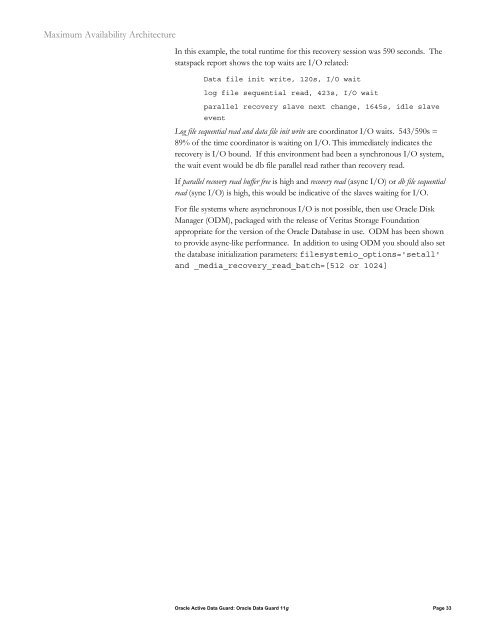MAA - Oracle 10gR2 Redo Transport and Network Best Practices
MAA - Oracle 10gR2 Redo Transport and Network Best Practices
MAA - Oracle 10gR2 Redo Transport and Network Best Practices
Create successful ePaper yourself
Turn your PDF publications into a flip-book with our unique Google optimized e-Paper software.
Maximum Availability Architecture<br />
In this example, the total runtime for this recovery session was 590 seconds. The<br />
statspack report shows the top waits are I/O related:<br />
Data file init write, 120s, I/O wait<br />
log file sequential read, 423s, I/O wait<br />
parallel recovery slave next change, 1645s, idle slave<br />
event<br />
Log file sequential read <strong>and</strong> data file init write are coordinator I/O waits. 543/590s =<br />
89% of the time coordinator is waiting on I/O. This immediately indicates the<br />
recovery is I/O bound. If this environment had been a synchronous I/O system,<br />
the wait event would be db file parallel read rather than recovery read.<br />
If parallel recovery read buffer free is high <strong>and</strong> recovery read (async I/O) or db file sequential<br />
read (sync I/O) is high, this would be indicative of the slaves waiting for I/O.<br />
For file systems where asynchronous I/O is not possible, then use <strong>Oracle</strong> Disk<br />
Manager (ODM), packaged with the release of Veritas Storage Foundation<br />
appropriate for the version of the <strong>Oracle</strong> Database in use. ODM has been shown<br />
to provide async-like performance. In addition to using ODM you should also set<br />
the database initialization parameters: filesystemio_options='setall'<br />
<strong>and</strong> _media_recovery_read_batch=[512 or 1024]<br />
<strong>Oracle</strong> Active Data Guard: <strong>Oracle</strong> Data Guard 11g Page 33

















